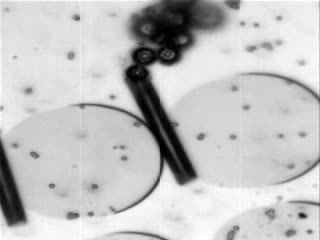 | ||
Although any kind of small pump is often referred to as micropump, a more accurate definition restricts this term to pumps with functional dimensions in the micrometre range. Such pumps are of special interest in microfluidic research, and have become available for industrial product integration in recent years. Their miniaturized overall size, potential cost and improved dosing accuracy compared to existing miniature pumps fuel the growing interest for this innovative kind of pump.
Types and technology
First true micropumps were reported in the mid-1970s, but attracted interest only in the 1980s, when Jan Smits and Harald Van Lintel developed MEMS micropumps. Micropumps have a great potential for bio-inspired applications e.g. a flexible electromagnetic micropump using Magnetorheological elastomer to replace lymphatic vessels.
Within the microfluidic world physical laws change their appearance: As an example, volumetric forces, such as weight or inertia, often become negligible, whereas surface forces can dominate fluidical behaviour, especially when gas inclusion in liquids is present. With only a few exceptions, micropumps rely on micro-actuation principles, which can reasonably be scaled up only to a certain size.
Micropumps can be grouped into mechanical and non-mechanical devices: Mechanical systems contain moving parts, which are usually actuation and valve membranes or flaps. The driving force can be generated by utilizing piezoelectric, electrostatic, thermo-pneumatic, pneumatic or magnetic effects. Non-mechanical pumps function with electro-hydrodynamic, electro-osmotic, electrochemical or ultrasonic flow generation, just to name a few of the actuation mechanisms that are currently studied.
Additionally, chemically powered non-mechanical pumps have been fabricated by affixing nanomotors to surfaces, driving fluid flow though chemical reactions. A wide variety of pumping systems exist ranging from biological enzyme based pumps, to organic photocatalyst pumps, to metal catalyst pumps. These pumps generate flow through a number of different mechanisms including self-diffusiophoresis, electrophoresis, bubble propulsion and the generation of density gradients.
In microfluidics, capillary pumping plays an important role because the pumping action does not require external actuation power. Glass capillaries and porous media, including nitrocellulose paper and synthetic paper, can be integrated into microfluidic chips. Capillary pumping is widely used in lateral flow testing. Recently, novel capillary pumps, with a constant pumping flow rate independent of the liquid viscosity, were developed, which have a significant advantage over the traditional capillary pump (of which the flow behaviour is Washburn behaviour, namely the flow rate is not constant) because their performance does not depend on the sample viscosity.
